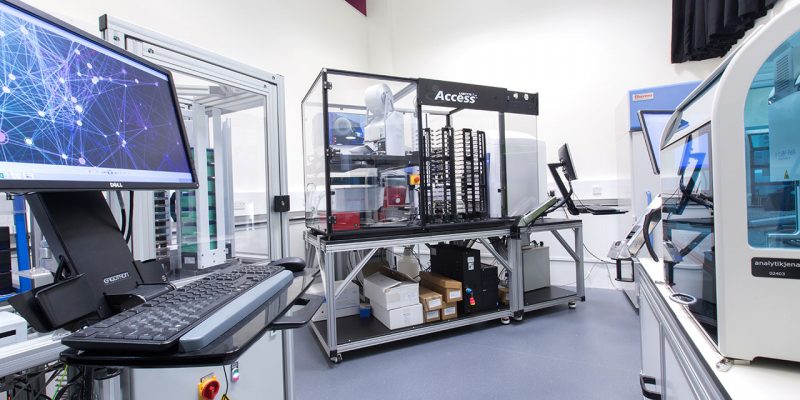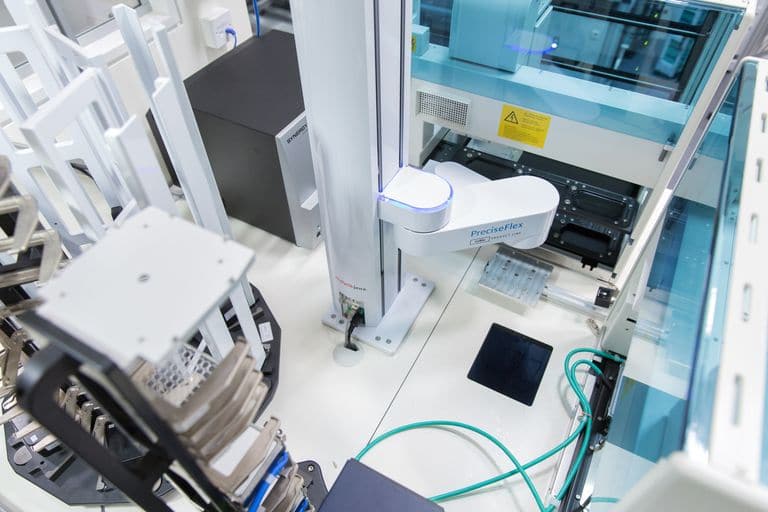This story is brought to you by SynbiCITE, which is accelerating the commercialization of synthetic biology applications. To learn how SynbiCITE is nucleating a sustainable UK economy, visit www.synbicite.com.Just as Henry Ford’s assembly line revolutionized the automobile industry, synthetic biology is being revolutionized by automated DNA assembly (see SynBioBetaLive! with Opentrons). The key features of an assembly line translate well into the field of synthetic biology – speed, accuracy, reproducibility and validation. Instead of welding chassis together, small robotic arms are lifting delicate plates holding dozens of samples, adding and removing miniscule amounts of fluid.In 2014, Imperial College London received £2 million to develop a DNA Synthesis and Construction Foundry to operate with SynbiCITE, the UK Innovation and Knowledge Centre for synthetic biology. Speaking at the Foundry’s inception, SynbiCITE co-director Prof. Paul Freemont said, “Standardizing the methods for synthesising DNA is crucial if we are going to scale up efforts to design and create this genetic material. The new DNA Synthesis and Construction Foundry will streamline and automate the 'writing' of DNA at an industrial scale so that tens of thousands of designed DNA constructions can be built and tested.”The London DNA Foundry, as it’s now known, represents another major investment from the UK government to boost the synthetic biology industry by addressing global challenges and ultimately providing long term contribution to a sustainable bioeconomy. The Foundry itself has cutting edge automation and analytics technology that addresses the biggest challenge in synthetic biology: how to make high-throughput synthetic DNA constructs and test their specific functions.
“Scientific experimentation in synthetic biology can be reduced to moving tiny bits of liquid from one place to the other, a foundry can be a powerful tool when combined with a relevant problem at scale,” explains Dr. David McClymont, Head of Automation at the Foundry. Once suspended in liquid, DNA can be altered in many ways. It can be cut up, stuck together, copied en masse, or mutated. The DNA is then transferred to a microbe like E. coli or yeast to make a library or test the gene product. Organisms “transformed” with this synthetic DNA construct, once in liquid growth culture, can be screened and sub-cultured by the automated platform.Dr. McClymont joined the Foundry just prior to its launch. With a background in automation, high-throughput screening and assay development, he and his team coax a sophisticated suite of robots to solve novel and complex synthetic biology challenges.

As a part of SynbiCITE, the Foundry collaborates with numerous academic and industrial partners to solve high-throughput problems. Creating novel solutions for each individual challenge has added to the Foundry’s expertise in experimental procedure, adopting a four-point engineering approach called ‘Design, build, test, learn’.Each stage relies heavily on advanced software, integrated into the automated platform. Computer aided design (Bio-CAD) software JMP is used to design experiments. This can interface with the Foundry’s own software developed by Dr. McClymont. This bespoke system, called AMOS, is a software that interfaces with the robots. It also allows users to design and run their own experiments. This software also takes the data retrieved and readies it for analysis and modelling, the “learning” step at the end of the cycle.Once the project is designed, a multitude of state-of-the-art robots take over. Liquid handling systems including CyBio FeliX and the acoustic-based Echo from Labcyte can deal with 15,000 designs per day. A dizzying array of genetic manipulation techniques can be performed, as well as advanced DNA assembly techniques like BASIC, Golden Gate, and Gibson with subsequent transformation into the microbial chassis of choice.Once grown in their appropriate experimental conditions, the microbes and their metabolites – that is, the proteins and chemicals they produce – can be analyzed. The Foundry can monitor their engineered strains from growth, showing each step in the process from gene expression to protein creation to final product formation, allowing them to identify any bottlenecks in the process. This is necessary for improving each cycle.
“Ultimately, unless you solve all these problems, take the whole process apart, and optimize each step of those processes before you put it back together again, it’s not going to work robustly and reliably,” says Dr. McClymont, adding “The process of relentless optimization is about identifying bottlenecks when you have the appropriate time to deal with them. I love finding a bottleneck because it just makes another problem to solve. Those bottlenecks are entirely dependent on the scale of the problem.”Dr. Tom Ellis is one scientist who has successfully used the Foundry to de-bottleneck his high-throughput experiments. He says, “I would say the big bottleneck we have in synthetic biology is screening.” Thousands of DNA constructs can be made in a single pot, but there’s no way to screen for the best one among them by simply picking it out. Automation, and working with the Foundry, has allowed researchers like Dr. Ellis to make those thousands of DNA constructs separately so they can be screened individually.This was no major issue for the Foundry, after all this is what it was designed to do, but Ellis had a bigger challenge. He wasn’t working with E. coli bacteria, which the Foundry had originally optimized itself for. He was using the other great microbial workhorse: yeast.“We had to work out how to do automated transformation of yeast to get the DNA in. That was probably the hardest point just because it’s a different process to getting DNA into E. coli, so different temperatures involved, different physical and chemical methods involved. But we managed to achieve that and it’s working pretty well.”

Dr. McClymont and Dr. Ellis highlight that, as DNA assembly and strain development speeds up, a new bottleneck appears further down the testing part of the process in detecting target metabolites. Dr. David Bell, formerly of GSK, leads the Foundry’s analytics department and is developing strategies to increase the throughput.“That’s an ongoing challenge that we need to meet. In synthetic biology, chemical analysis can be a bottleneck as most methods are relatively slow and process samples in serial. What we do is develop solutions that are ‘fit for purpose', meeting the demands faster but maintaining the required quality. Essentially do things smarter, faster,” says Dr. Bell.To detect the compound of interest from the sea of products found in the cell culture, the first step is usually separation. This is typically done by forcing the prepared medium through a special column with liquid or gas, which separates compounds by size in a process called chromatography. The separated compounds can then be detected individually by other methods like UV absorbance, refraction, or mass spectrometry (MS).The separation step can take quite a long time compared to the relatively quick detection step. Gas chromatography is typically faster than liquid chromatography, but not everything can be separated by gas. Standard setups typically run the separation in the tens-of-minutes to one-hour range, however Dr. Bell has significantly decreased the time required for separation at the Foundry.“Using a full gradient LC [liquid chromatography] separation, we can run LC/MS assays reliably and robustly with a cycle time of less than 1.5 minutes. We now have the capacity of ten 96-well plates a day for the output of the London DNA Foundry.”Dr. Bell is keen to keep the Foundry on top in terms of high-throughput analytics and recognizes even 960 samples per day is not enough. “An emerging high-throughput analytical technology is ambient ionisation mass spectrometry. When combined with ion mobility, you’ve got an extra degree of selectivity without the need for relatively slow chromatography. Applications include ultra high-throughput screening prior to more detailed characterisation by LC/MS.”In a nutshell, ion mobility works by separating molecules in an electric field which tells you their size and shape based on how long it takes to travel a set distance. Compared to liquid and gas chromatography separation methods, ambient ionisation MS is a game changer.

SynbiCITE director Paul Freemont is extremely proud of the Foundry, highlighting that pharmaceutical background of Dr.s McClymont and Bell adds huge value to their partners and projects in terms of design and reproducibility, essential for nascent synthetic biology companies to achieve.The Foundry is open to collaborations with everyone, both in academia and industry. Their highly skilled team have learned by solving numerous novel synthetic biology problems for their partners, and share that with their collaborators, as Dr. McClymont summarizes neatly, “At the Foundry we can train our staff on our assay development approach. It’s an ability to break down a problem, that relentless desire to fix those little optimisation problems, and over time we had people with lots of experience doing this and we could point everyone in those directions.”Dr. Bell is also keen to help emerging synthetic biology companies with the Foundry’s resources. He echoes sentiments shared by SynbiCITE directors Paul Freemont and Richard Kitney when he says “Part of the translation process is proof of concept, leading on to the development of prototypes, thus enabling companies to attract further funding and become more viable as commercial entities. We help companies reduce the risks yet maintain the potential rewards. SynbiCITE works with a wide range of companies at different stages of growth.”How does the future look for automated synthetic biology? Dr. McClymont shared one thing that irks him. “One thing that does annoy me a little bit is having to do DNA assembly in E. coli, clone those and miniprep them… Potentially enzymatic solutions will be useful in a few years’ time.” E. coli remains the workhorse of molecular biology, but with companies like Cell Free Tech removing E. coli from the equation, the assembly lines of the future will make Ferraris rather than Fords.If you are interested in collaborating with the London DNA Foundry, you can contact them through their website, or through SynbiCITE.SynbiCITE directors Paul Freemont and Richard Kitney will be speaking at the SynBioBeta 2018 Global Synthetic Biology Summit in San Francisco, October 1–3, as part of the Synthetic Biology Week. Register now!This story is brought to you by SynbiCITE, which is accelerating the commercialization of synthetic biology applications. To learn how SynbiCITE is nucleating a sustainable UK economy, visit www.synbicite.com.